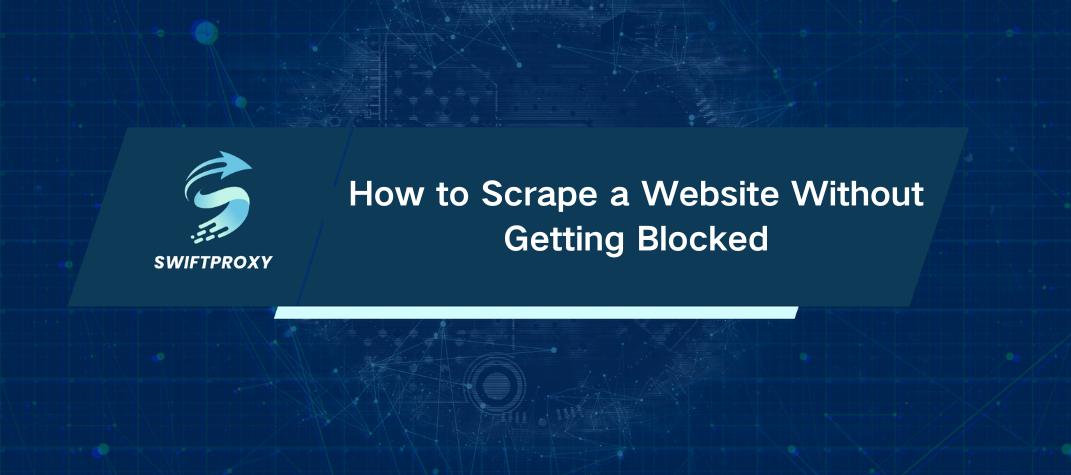How to Scrape a Website Without Getting Blocked

With the rapid growth of technology and the World Wide Web, obtaining information has become remarkably easy. Web data extraction allows individuals and companies to harness vast amounts of publicly available data, enabling them to make more informed decisions.
However, accessing information from a specific website often requires using the website's format or manually copying and pasting the data into a new document, which can be both tedious and time-consuming. Internet scraping offers a more efficient solution in such cases.
Understanding Web Scraping
Web scraping is the method used to collect data from websites. This data is then transformed and exported into a more user-friendly format, such as a spreadsheet or an API. Although web scraping can be done manually, automated tools are generally favored for their cost-effectiveness and speed.
Web scraping utilizes both web crawlers and web scrapers. A web crawler, or "spider," is an AI-driven tool that explores the internet by following links to discover and index content. In contrast, a web scraper is a specialized tool designed to extract data from web pages with precision and ease.
How to Avoid Getting Blocked While Web Scraping
Most websites block web crawlers and scrapers to prevent performance issues. Even if a site doesn't have explicit anti-scraping measures, it generally avoids web scraping due to its adverse effects on user experience. So, how can you extract data without getting blocked?
· Review the Robots Exclusion Protocol
Always examine the robots.txt file to ensure compliance with the site's policies. Verify that you are only crawling pages you are permitted to access. Even if the website permits web scraping, you might still face blocks, so additional measures are necessary.
· Utilize Proxy Servers
If a site detects that a single IP address is making multiple requests, it may become suspicious and block that IP. This can prevent you from accessing the data you need. Proxy servers can help by masking your IP address, allowing you to bypass such restrictions and continue data collection.
Proxy servers function as intermediaries between users and the websites they access. They act as a "middleman" through which all your online requests pass before reaching the target website or information. The proxy manages these requests and handles them on your behalf, either by retrieving responses from its own cache or by forwarding the request to the appropriate web server. Once the request is fulfilled, the proxy sends the data back to you.
While individuals might use proxies for personal reasons, like concealing their location when streaming movies, companies utilize them for a range of purposes. Proxies can enhance security, protect employees' internet usage, manage internet traffic to prevent crashes, monitor website access by employees, and reduce bandwidth consumption through caching files or adjusting incoming traffic.
Selecting the right proxy server depends on your particular needs and objectives. We recommend Swiftproxy for its dependable, secure, and high-speed connections available anytime and anywhere.
· Implementing IP Rotation
A rotating proxy is a tool that assigns a new IP address from its pool to each request. This allows you to run a script that sends multiple requests to various websites, each with a different IP address. The key function of IP rotation is to provide a unique IP address for each connection, helping to avoid detection and blocking.
For high-volume, continuous web scraping, users should use rotating proxies. They allow you to repeatedly access the same website while keeping your identity anonymous.
· Use Diverse Techniques for Data Extraction
Websites employ methods to analyze search patterns and detect when data is being scraped by automated systems rather than human users. Unlike humans, who navigate sites in varied, zig-zag patterns, web scraping often follows a predictable and consistent route. This regular behavior can be easily detected by anti-scraping mechanisms. To avoid detection, it's necessary to use diverse techniques for data extraction.
Data scraping differs from typical human browsing behavior. Unlike human users, who navigate websites in varied and unpredictable ways, data extraction is often more systematic and continuous, making it easier to detect. To reduce the risk of detection, regularly modify your scraping methods and incorporate random clicks across different websites. Additionally, simulating random mouse movements that resemble human activity can help create the impression of normal user interaction.
· Rotate User Proxy
To avoid being blocked, it's essential to rotate different user-agent headers with each request. Use a variety of real user-agent strings from popular web browsers. Servers are adept at detecting suspicious user agents, so it's important to use configurations that resemble those of legitimate users. Ensuring your user-agent appears as if it belongs to a real visitor can help prevent detection and blocking.
· Be Mindful of Anti-Scraping Software
As web scraping has become more widespread, many websites have implemented anti-scraping measures. Sites may flag unusual traffic or high download rates, especially if they originate from a single user or IP address. These patterns help websites distinguish between human visitors and automated scrapers.
Many websites use anti-scraping software to detect web crawling and scraping. One of the most common tools is the "honeypot," which is embedded in CSS and JavaScript libraries. These honeypots are invisible to users but trigger alerts when interacted with. If you want to learn more about this topic, you can follow our other blog posts.
Conclusion
As previously mentioned, effective proxy management is a key component of a successful web scraping strategy. For an easier web scraping experience, consider using Swiftproxy. Our proxy network incorporates advanced ban detection and request throttling techniques to ensure your data is delivered safely and efficiently.

















































